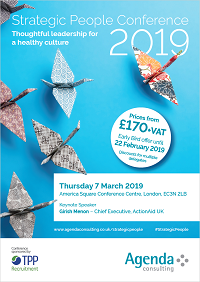This was my second year at the Strategic People Conference from Agenda Consulting. This year’s theme was ‘Thoughtful leadership for a healthy culture’. Once again I came away with lots of new ideas and questions to consider in my work with my clients.
Throughout the day there was ample opportunity to learn from different perspectives on engagement and organisational culture. We started the day with keynote speaker, Girish Menon from ActionAid UK, who left everyone smiling and feeling inspired. It was particularly interesting to hear about the feminist leadership principles that he and his board have implemented.
The rest of the time was given over to workshops and plenty of breakout time to chat with some of my fellow conference delegates. Sadly, with nearly 200 people there it wasn’t possible to talk to everyone!
Ten key points
1. Great leadership is not just about taking decisions based on data – great leaders must also use their judgement.
2. Leaders must ask themselves, who has their ear to the ground? Who will tell me what is actually happening across the organisation, even (especially) when things are not going as well as they should be?
Not everything that can be counted, counts. Not everything that counts, can be counted.
Albert Einstein
3. As organisations and individuals we have to get comfortable with living with ambiguity.
4. Lead in the way that works for you and your people – leadership is about the outcome that you need to achieve.
5. Organisations need to think creatively and differently about their volunteering roles and consider potential volunteers’ journey to finding an opportunity that works for them – if you make the application process too difficult or the roles too big, people will give up because they think it’s not for them.
6. Micro-activities – such as a one-off project like digging a garden – give you a chance to show what your organisation is like to connect with; once potential volunteers have a taste for what your organisation is like, they are more likely to come forward to do more.
7. When it comes to diversity and inclusion, it is the inclusion bit that is key, not a tick-list of ‘diverse characteristics’ – everyone should feel you offer a safe space for them.
8. The tone of an organisation should be set from the very top – trustees need to know what kind of workplace culture your organisation has and they should be asking questions to find out.
9. When it comes to safeguarding staff and volunteers, you need to make sure that people know what to do if they witness or experience an incident, as well as creating a culture where they feel comfortable to do so.
10. Moving to an agile way of working, where teams and individuals do not have designated workspaces within the office, can lead to changes in mindset as well as physical location. Changing how staff work also leads to a change in the way they think and breaks down team silos.
I really enjoyed hearing examples of how charities are addressing the various aspects of leadership, culture and engagement. I will be looking out for the email advertising next year’s conference and booking my ticket as soon as I can.
Until next time
Sarah

